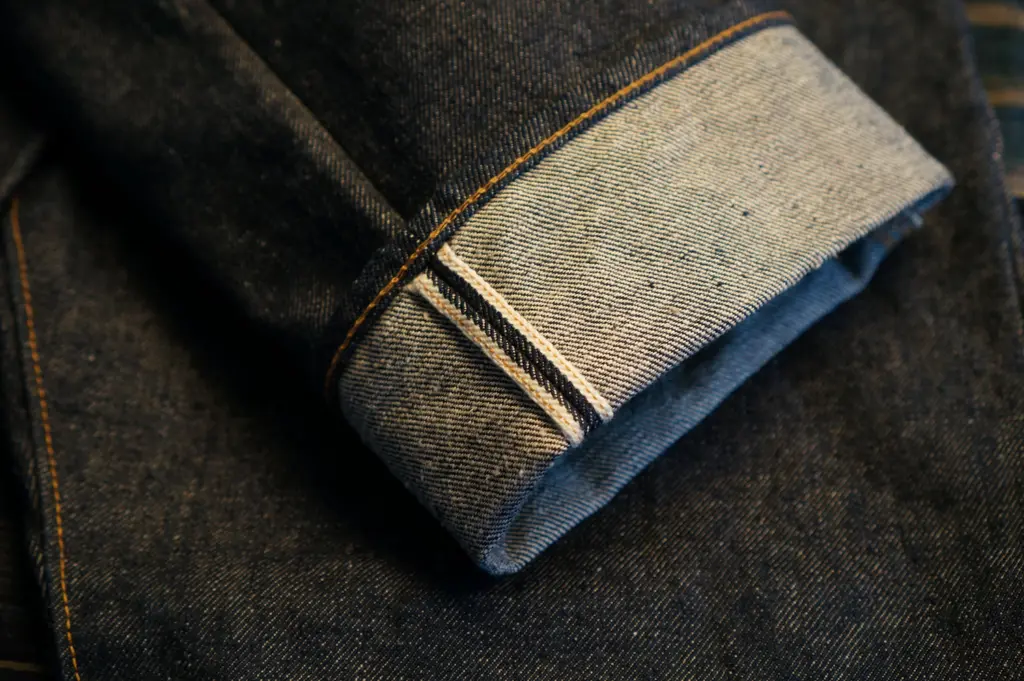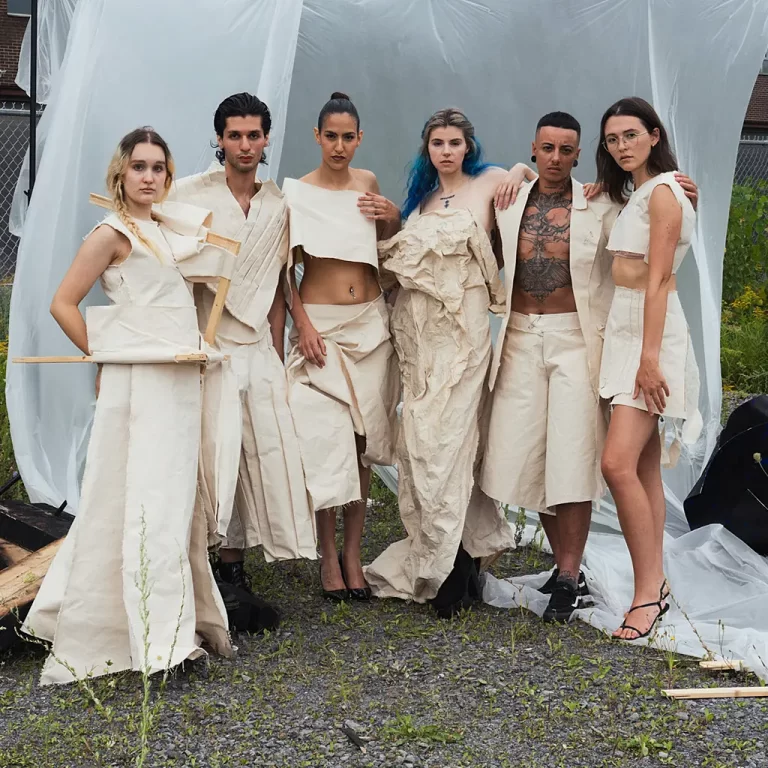No, you’re not imagining things.
Denim has really taken over most runways and racks in online and IRL shops, of late. It comes in many colours, shades and degrees of fade. It’s worn in dark washes, super pale, or dishevelled —clearly meant to show its recyclable aspect —, or gussied up and dressier. Luxe, even.
That’s happening now, for fall 2023, and even looking into spring/summer 2024, as witnessed at Ralph Lauren who, in a departure from the brand’s quiet luxury and preppy signature styles, showed floral printed jeans, fluted maxi skirts, denim blazers, and even distressed cargo jeans embellished with sheer tulle. It says a lot about the prevalence of the originally humble canvas that is now shown in other settings and styles.
If, at a certain point in time, denim was instantly associated with jeans, that is not what is being churned out of the fashion conveyer belts in 2023.

The Many Interpretations of Denim
Denim this year is showing up in the shape of shoes (sexy stiletto mules, chunky platform sneakers and cowboy boots — some with gaitors), corset tops and form-fitting dresses, siren skirts (à la Y2K), belted peplum jackets and blazers, and even (surprise!) wide-legged jeans. Denim also shows up in a plethora of other shapes of pants, too. Yes, we’re now way beyond the ‘skinny jeans are for dinosaurs’ debate, since the much-maligned thin silhouette is now back on the front row at some designer houses: Celine and Saint-Laurent, for starters. Sorry, Gen Z.
According to Montreal-based fashion journalist and teacher Stéphane Le Duc, “we thought everything had already been done with denim, but there’s still much more to explore. Big fashion names like Chanel and Vuitton all showed denim bags in the last year. It’s almost the ultimate step in integrating this type of thick cotton twill into a true fashion item, and the fabric is being used like leather. After having reworked denim jackets into luxury garments with lots of detailing and rhinestones, we’re going for other wardrobe staples.” He explains that denim is being elevated through the addition of patterns and prints, like jewels on the shoulders of jackets, embroidery and rhinestones, which brings the humble textile to an almost-couture level.
Low-rise jeans? While not as extreme as the original bumster created by Alexander McQueen in 1994, they are making a timid comeback. See Bluemarine’s spring summer 2023 offering, with its flared skinnies, and Diesel’s collection for Spring/Summer 2024 in a ruckus techno rave vibe putting forth the legendary silhouettes of the brand, including some low-waisted models. “Glenn Martens, the creative designer at Diesel, has been brilliant in diving into the archives of the brand, reinterpreting the iconic label’s strong statements from the beginning of the 2000s for the current era,” says Stéphane.

Going for Wider and Looser Jeans
It’s been said the pandemic sealed the fate of the skinny jean, as nobody really wanted to work from home in a style of trousers so tight and unforgiving when it comes to comfort. Oh, that and the fact that Get Zs don’t want to look like their parents who have loved and worn their skinnies for over a decade. So, yes, denim jeans are getting wider as pants reminiscent of the 90s are gaining in popularity, with the top sellers being boyfriend jeans and dad fit jeans. Straight and loose where we’re at, for both women and men.
According to Stéphane, for the younger generation it’s an “awesome discovery in wanting to getting away from garments that are form-fitting. It’s about rejecting the skinny and preferring a wider, more opulent silhouette.”
But what’s really shifting is the incredible variety of fits and leg shapes that are cohabiting on store shelves — and all selling at a brisk pace. Just at Canadian fashion retailer Simons, there are close to 100 models of women’s jeans in different cuts and widths, from skinnies and bootcut to flares and barrel legs. Men? Still at Simons, the selection varies from skinny/slim to something called ‘new proportions,’ including a Korean-made shortened pleated loose jean ‘with amplified dimensions.’
Ultra-wide-leg jeans with puddle hems was the denim style du jour at the major Fashion Weeks this year. Bold, and practical for winter, these jeans serve the clever dual purpose of taking up a lot of space while also feeling like a comfy cotton blanket across your legs. Ideal to create your invisible bubble on transatlantic plane rides and on cities’ public transport. There is, of course, inherent drama in the exaggerated shape of each pair—most designers call theirs “extreme” wide legs. To balance proportions, they’re best styled with an understated top.
Unlike skinny jeans, looser denim styles don’t require fabric embedded with added elements like elastane, which enables stretchiness, or even polyester, to make the fabric more resilient. And that paves the way for new wider styles being more sustainable.

The Question of the Selvedge
Every true denim aficionado knows the importance of a great selvedge (literally a contraction of the words ‘self edge’), which refers to the natural end of a roll of fabric that prevents the fraying or unraveling of the material when made into a pair of jeans. It also leads to a tighter, denser weave. Selvedge fabric edge is one of the most distinctive aspects of Japanese denim, usually woven with a signature red stripe, although green, white, brown, and yellow are not uncommon.
A premium item for collectors, Japanese denim is more costly to produce since it can only be woven at a width of 31 inches, which is about half the width of non-selvedge denim, and is woven on old looms requiring more skill and adeptness. This is reminiscent of some premium cotton T-shirts also made in Japan on vintage knitting machines.
The call for this type of finishing is so important that true denim aficionados — the collector type that will throw thousands of dollars for a specific vintage item or a hard-to-find model — can now get their premium selvage fix through some high-end Canadian denim brands like Naked and Famous, Atelier Détails, and other small fashion studios like Montreal’s Spare Jeans emphasizing the quality of raw denim and custom-made models.
“The use of raw denim is becoming more widespread, and this fabric is gaining momentum as designers choose it to elevate it with more elaborate designs, trimmings and overstitching,” says Stéphane.
But What is Raw Denim, Exactly?
Simply put, raw denim is denim fabric that is unwashed and without the addition of any percentage of stretch. Up until the early 1970s, all jeans were made this way, requiring from the consumer to break them in because of their stiffness and total absence of spandex or Lycra to achieve form-fitting results. Raw denim requires some breaking in due to its rigidity. It eventually softens, moulds to your body and creates its own lines, creases and patterns on the fabric where some of the dyes have faded. That’s the beauty of raw denim, as no two pair are the same. The garment comes alive with you; your unique body and the way you move. So, in a way, it’s really closer to a couture garment.
From a sustainability standpoint, one of the best things about raw denim is its much smaller carbon footprint compared to washed denim. On average, a washed and pre-distressed pair of jeans requires 42 litres of water to achieve that worn-in look. On top of that, chemicals are generally used to alter the fabric, not to mention the electrical power required to dry the jeans after they are washed, as well as the often cheap labour needed to distress the jeans by hand, when the design requires it and the garment is manufactured in other countries.
Is it time to go back to the more authentic, rugged, type of denim that, over time, will be embedded with our own unique figure and lifestyle? Maybe that’s the future of modern couture…





